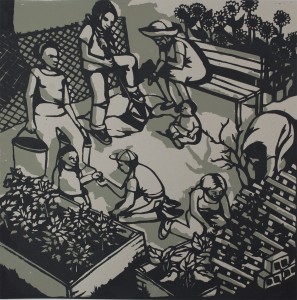The “Magic” of A Peacemaking Circle
Recently I have been working with adjudicated youth on probation who have been given mandated community service hours rather than being placed in juvenile detention.
I am often asked how we utilize restorative work for youth who already have been arrested and are often struggling with staying in school. What role can restorative circles play in helping youth in trouble with the law repair the harm that they have done to the community?
The effectiveness is so apparent when one is given the opportunity to be a part of this programming that it makes it almost hard to explain. The shift often comes quickly—as a sullen youth arrives looking as if he would rather be anywhere but here after a long day at school. “Oh no. Not another class where I am expected to participate and act respectful. How long do we have to be here?”
Then they see the Ceasefire men arrive to join us. “Oh no. Now we are going to be lectured about how if we keep getting into trouble we will end up behind bars in a prison.” “Okay. Give us our orange vest and we will go out and pick up garbage in the park.” No. That is not what we will be doing. We are going to do meaningful community service. But first, we are going to explore and strategize what that means.
The “magic” starts when we take our place in the circle. I explain briefly that we are sitting in the circle because each one of us will have the opportunity to speak as we pass the talking piece around. No one is the EXPERT. We are all part of the whole. We are all sitting equal distance to the center that holds the truth, the answer, the story. If we are not ready to speak, we can pass. Still, to be a part of the circle we will all actively listen.
“That’s it?”
Well…it may not appear to be profound…and yet, in every circle there are myths that are deconstructed, relationships formed, voices being heard. A few examples:
A photo was passed around of a tall black man with locks and his cap falling off to one side. He looked like he was passed out with one hand covering his face and it seemed he might fall out of his chair if started, as he was slumped down with his shoulders sliding off the back of the sofa.
“I’m going to pass this picture around and have everyone look at it and write whatever thoughts you have about this man. Where do you think he lives? Does he have a job?
What kind of food does he eat? Does he own a car? Did he go to school? Would you want to know him?” “Does he look kind?”Each person spoke when they were passed the talking piece. Comments were abundant with judgement. And not very positive.
“He looks high on ganja. He looks like he might be homeless and broke. The man is not kind–I wouldn’t go near him. He looks lazy.”
After everyone spoke, I explained that the man was an award-winning, highly sought-after musician who travels internationally and extensively. He is someone who values prayer, meditation, and compassion more than his career. He is generous and intelligent. The picture was taken by someone in Paris as he was jet-lagged and was waiting for a concert to begin after a sound check. He was sleeping.
“Oh wow. We shouldn’t be judging people.”
“Well, I think we have to make judgements sometimes—it is part of our human nature and it can keep us safe and help us make decisions. But perhaps, we can remain open in our judgements to learn more about people and not make assumptions from one glance.”
This started one of the best and honest discussions about racial profiling and being labeled as a troublemaker. The youth talked about how they have no place to go to meet with friends as they are often stopped and searched and told they cannot loiter. Still, where can they go on a hot July night at 9 pm without money?
__________________________
In another circle we talked about mandated anger management. It has been enlightening to me that many of these programs talk about anger as if it were an unnatural, depraved emotion that can or should be exorcised from people. I read a quote from Audre Lorde: “ My anger has meant pain to me but it has also meant survival, and before I give it up I’m going to be sure that there is something at least as powerful to replace it on the road to clarity.”
Again, another thought-provoking circle ensued. Anger is human. It can be used as protection, as a motivator, and fuel, as a warning signal that something needs to be changed. “Maybe WE could go to a CAPS meeting and talk to the police and ask them what we are supposed to do when we are unfairly harassed and searched.”
This led to more exploration regarding accountability and how youth who are disconnected from their communities and thought of as “problems”—how can they feel accountable for their actions? How can they care about their community that doesn’t seem to care about them?
These questions and stories came from the youth who only a couple weeks earlier, had walked in saying, “What are going to do? How long do we have to be here?” Now they come into our space and tell me that they know friends at school who want to come to our program.
We cannot address problems and issues if we do not recognize and listen to one another. That is what we are doing here. And together we are going to develop real-life strategies and tool-kits to get through. Together—our community.

